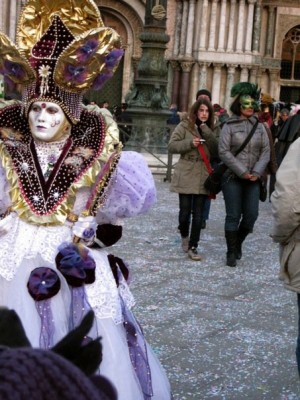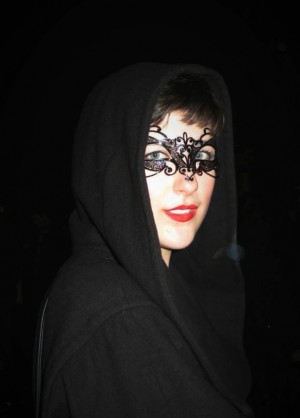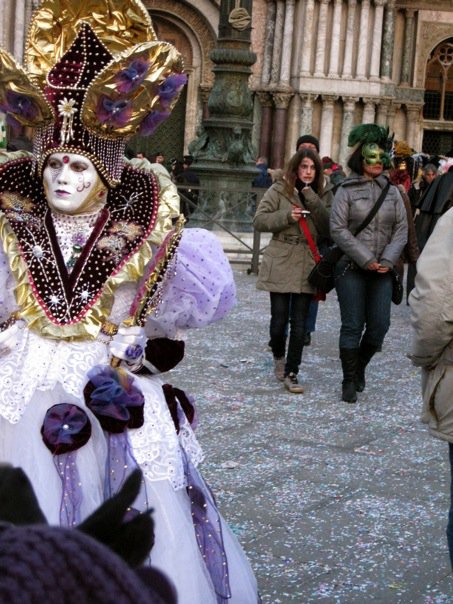I exit the train station just as the street lamps flicker on, gilding the green-blue of the canal and prompting cheers from the growing crowd. I know it’s time. I withdraw the mask from my handbag. It’s black metal, an intricate filigree that covers the space between my eyebrows and the tip of my nose, bought for peanuts from a tiny shop full of strange detachable identities somewhere deep in the twisting narrow streets of this city a week before. My friend ties the ribbon around my head, and I help her with hers. Suddenly, we are transformed, creatures of nighttime mystery, and Venice is a new world, filled with possibility and crackling energy. It is Martedi Grasso, better known as Fat Tuesday or Mardi Gras, and the last night of Carnevale.

February and March seem at first a dreary time of year to visit the north of Italy. Far from the blazing summer months when Italy attracts most of its visitors, the Veneto region in the country’s northeast is chilly and shrouded in a fine silver mist, but this is when the region is at its most mysterious and beautiful. It’s also when Carnevale begins, a month-long marathon of revelry, costumes, and ancient tradition that’s fun for all ages. Carnevale is where paganism and Catholicism have happily collided to provide a period of pre-Lent catharsis for centuries, not only as an excuse to party in the street, but also to foster an environment in which people of all kinds can interact freely. On the surface, it’s rampant hedonism, but amongst the marching bands and ornate costumes one finds a unique kind of camaraderie and confidence. As for me, I’ve found a new favorite holiday — Thanksgiving, Halloween, and Festivus, I’m afraid, have fallen by the wayside forever.
Carnival—a word whose origins mean “goodbye meat”—is an ancient tradition deriving from pagan festivals of Bacchanalia and Saturnalia that has grown into a Catholic context preceding the forty days of Lent, starting on Shrove Tuesday and ending just before Ash Wednesday. Though different countries around the world have different traditions, all share in the spirit of shedding social bonds and reveling in a public dimension. The Carnevale of Italy, with its elaborate masks and costumes, is the most famous, especially in Venice. Introduced in 1162 and reaching its height during the Renaissance, Carnevale provided a welcome respite from one of the most strictly codified societies of the era, a time in which class and rank mattered little and pleasures could be enjoyed without restraint under the anonymity of a mask. The holiday was sadly outlawed in 1797 under the control of the King of Austria, who forbade wearing masks in public. Carnevale remained illegal until 1979 when the Italian government revived the tradition, and the streets filled with colorful masks once again. Now, millions flock to Venice to enjoy the spectacle every year.

It is a spectacle indeed—the streets fill with music and performers, bottles of wine are passed from mouth to grinning mouth, and frittelle (magical fried dough balls available only during Carnevale, filled with fruit, cream, or zabaglione) seem to float, sugar-dusted, through the air. The cobblestones are covered in tiny scraps of colored paper, Italy’s answer to confetti known as coriandoli. Youngsters throw flour at each other in the piazza. People of all ages don costumes, from animal onesies to elaborate recreations of Renaissance garb in brocade and silk. Most importantly, all are masked.
The masks themselves are works of art, ranging widely in form and expression, from the traditional square-jawed bauta to the bizarre long-beaked “plague doctor” mask (originally intended for practical use, as plague was rampant in Venice, as in most of Europe, during the 14th century), to the eerily blank larva masks that cover the entire face from chin to forehead. Feathers, gems, gold, and calligraphy decorate papier-maché surfaces, transforming the ordinary to extraordinary and freeing one from the bonds of their daily identity under the mask’s protection.

I run across another bridge, a sleek black gondola carrying a couple mid-embrace passing beneath me, and find myself in an open piazza full of masked strangers and a rowdy marching band. I drift into the crowd and begin to dance, inhibitions far behind me, and I realize that, though I can’t see a single face and I know no one beyond my own party, I am not afraid at all. Earlier this year, at Halloween, I wrote a piece about masks and what they can do to scare people—the boundaries they create, and the trust they can help eliminate. Here, in this happy crowd, it’s just the opposite. It’s as though my mask is a transparent window, not a closed door… and the view is magnificent.

